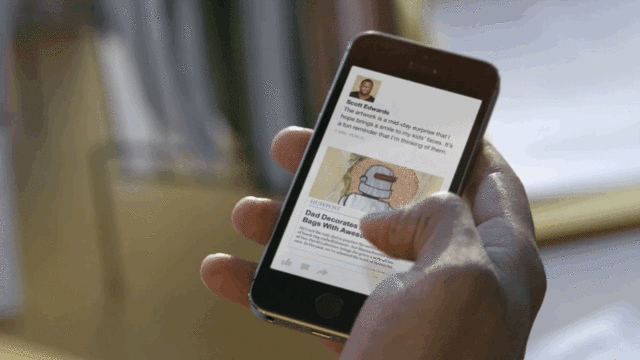Mobile design has always been something of a sore spot for Facebook. The social network has never quite figured out how to dominate our consciousness on smartphones beside apps like Twitter, Snapchat, and Angry Birds, leading to a set of experiments that ranged from acquisitions (Instagram) to sad clones (Facebook Poke) to innovative, but total flop mobile operating systems (like Facebook Home).
In response, Facebook has formed a new Creative Labs division to build better mobile apps, and an iPhone app called Paper is their first product.
Paper radically re-imagines what Facebook is on a mobile device as a fluid river of cards featuring news articles, photos, status updates, and more, with no ads to sully the experience (yet). It's being released next week on February 3rd, just one day before Facebook's 10-year anniversary, and there's a reason for that: Paper is the opening sentence in Facebook's next 10-year plan.

A beautiful app designed from the ground-up with the iPhone in mind, Paper owes its design lineage to a number of other apps. Paper presents the standard Facebook feed in the fluid, elegant style of Flipboard. It makes writing posts as easy as using Medium or Svbtle. Loren Brichter--designer of the original Twitter app, and the popular iPhone game Letterpress-- worked with Facebook to make the interface 99% invisible as possible, with news stories presented in Twitter-like cards, wide photos that pan as you tilt your phone, and UI elements that simply fade away when they aren't in use.
Although Paper isn't out yet, early previews are ecstatic. It's the first app out of Facebook's newly formed Creative Labs division, which is described as a way to allow teams within Facebook build standalone mobile experiences with the same dexterity as start-ups.
What Paper represents, then, is more than just Facebook finally taking design seriously on mobile. It's the future of Facebook, not as a monolith social portal, but as the platform underlying a series of apps designed from the ground-up for mobile.
A reason why Facebook has had such a hard time making an elegant transition to mobile is, well, Facebook itself. A desktop social network that wanted to be all things to all men, Facebook was designed to be a big-screen, link-filled hub that owes more of its lineage to the web portals of yesteryear than streamlined, mobile-first platforms like Twitter.

Facebook was designed assuming you would keep it open all day; it always wants you to play another game, take another poll, click another link, or like another photo. Facebook was designed to suck users in, but not spit them back out. That design ethos works great on a desktop, but it's incompatible with smartphones and tablets. We sip our apps. We open them for a few minutes at a time, then exit them just as quickly. In mobile, Facebook can't succeed as just one app among many that you occasionally open; it needs to be not just the app you have open now, but the next app you surf to, and the one after that.
Paper is an important evolutionary step for the monolithic social network. There may be no room in people's pockets for a monolith, but there is room for a handful of pretty gems. That's what Facebook Creative Labs is meant to be: a roomful of stone cutters who crack the monolith up and polish the shards to make their facets shine. And Paper is just the first one.